Japanese Candlestick Charts: More Light on
Price Action
(Input for this tutorial came from
Robert W. Colby, author of The Encyclopedia
of Technical Market Indicators, and the
Technical Analysis Institute book, Japanese
Candlestick Charts)
Candlestick charts provide a more visual
presentation of price action than traditional
bar charts and have become the chart of choice
for many technical analysts.
One candlestick itself can provide important
information about the strength or weakness of
the market during a given day or other time
period, depending where the close is relative to
the open. However, a candlestick pattern usually
takes several candlesticks to produce chart
formations that give the best signals.
The key in candlestick chart analysis is
where a given candle or candlestick formation
occurs during the market action. Candlesticks
may look identical but have an entirely
different meaning after an uptrend than they do
after a downtrend.
Because they can be used in analysis in much
the same way as bar charts, candlestick charts
have quickly become a favorite of traders and
analysts since being introduced to the West in
1990. Candlestick analysts have also added a
little mystique to candlestick charts by giving
various patterns clever names and providing more
descriptive characteristics for these patterns
than is the case in typical bar chart analysis.
Both types of charts have their double tops,
inside days, gaps and other formations. But
candlestick analysis ascribes more meaning to
the candlestick "bodies" – price action between
the open and close – and to the "shadows" or
"tails" – price action that takes place outside
of the open-close range for a period.
Because of their popularity in recent years,
you should become acquainted with the nuances
and terms of candlestick charts if you aren't
already.
Candlestick Chart Basics
Japanese candlestick chart pattern
recognition has been meticulously refined over
hundreds of years of actual experience by
Japanese traders, becoming a technical tool of
great and growing significance around the world
in recent years.
Japanese candlestick charts have caught on
rapidly in the West since 1991, when Steve Nison
published the first book written in the English
language on the subject, Japanese
Candlestick Charting Techniques: A Contemporary
Guide to the Ancient Investment Techniques of
the Far East. He added another book a few
years later, Beyond Candlesticks: More
Japanese Charting Techniques Revealed. In
1992, Greg Morris thoroughly described and
quantitatively tested candlestick patterns and
found that many were highly accurate in his
book, now titled Candlestick Charting
Explained. A number of other books have
been written on candlestick charts since then.
According to Morris, Japanese candlestick
pattern recognition is based on 160 rules that
Munehisa Honma developed from 1750 to 1803.
Honma owned a great rice field near Sakata, on
the west coast of northern Honshu. He traded
rice with such expertise that he grew extremely
wealthy. His trading rules became known as
Sakata's Method, Sakata's Law and Honma
Constitution. Honma emphasized the importance of
trading in harmony with the trend. After a price
rise, however, price eventually must
fall: it takes more force to cause price to rise
than to fall. When there is no trend, stand
aside in trading range markets.
East Meets West
Candlestick charts have been adopted quickly
and easily in the West because they have many
similarities to the long-familiar bar charts.
All the long-established Western chart pattern
recognition methods can be applied directly
without modification to candlestick charts. And
most computer programs can construct candlestick
charts just as easily as bar charts. When
plotting by hand, candlestick charts take just a
little more time than a bar chart. The colorful
and exotic names and Eastern mystique adds to
the appeal of candlestick charts.
Nison believes that candlestick charts can
offer signals in advance of traditional Western
bar charts: Candlestick charts can reveal a
trend change in fewer trading sessions, offering
timing advantages. Still, “relying on Japanese
candlestick charts alone is like leaning your
ladder against a cloud,” Nison cautions. The
major trend is more important than a few
candlesticks. Rather than narrowing his focus to
any one tool, Nison wisely emphasizes a
“trading triad,” a combination of (1) sound
money management discipline, (2) Western
technical analysis methods for analyzing trends
and patterns and (3) Japanese candlestick chart
interpretation.
Three is a recurring number in both Japanese
and Western technical interpretation.
Contratrend corrections often run for three
candlesticks. A narrowing of price range and
length of real bodies over three candlesticks
signify a loss of momentum and warn of a
probable price reversal. Many reversals require
three candlesticks or three movements or three
failed attempts at trend progress before
changing direction.
Like R. N. Elliott, the Japanese
independently recognized three impulse waves
advancing a wave of larger degree. Also, like
Charles Dow and his successors, the Japanese
independently recognized three psychological
phases of a bull market (skepticism, growing
recognition and enthusiasm) and three phases of
a bear market (denial, fear and disgust). That
traders and technical analysts from opposite
sides of the world and working in isolation
arrived at similar interpretations might imply
that there is something here that is universal
and very basic to human behavior.
Constructing Candlestick Charts
Japanese candlestick charts can be drawn for
any time period. The most popular time
interval to plot is one day, with its obvious
and readily available open, close, high and low
prices. Short-term traders may choose to plot
time intervals measured in minutes. For example,
a 30-minute candlestick chart could divide the
6.5 hours of the New York Stock Exchange trading
day into 13 intervals, using the first price in
each half-hour interval as the open and the last
price in each half-hour interval as the close.
Longer-term investors consult weekly
candlestick charts, using Monday's open and
Friday's close to define a weekly candlestick
chart's real body. Monthly candlestick charts
are constructed using the first trading day of
the month's open and the last trading day of the
month's close to define the monthly real body.
Japanese candlestick charts are fully
compatible with Western charting techniques
because they are nearly the same as Western bar
charts, except that the range between
the opening and closing prices is highlighted
and given special emphasis in candlestick chart
interpretation. The high and the low price for a
period are represented exactly the same way in
both Western bar charts and candlestick charts.
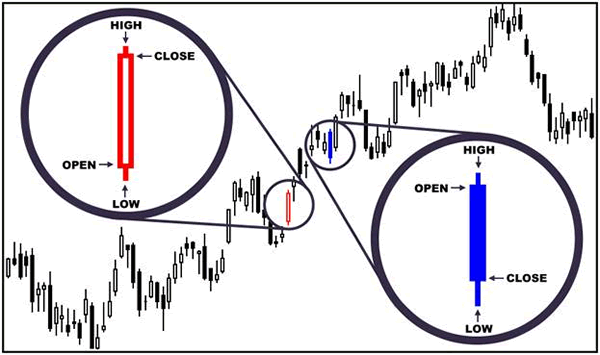
Source:
VantagePoint Intermarket Analysis Software
The real body is the price
range between the period's open and close. This
is drawn as the widest part of the candlestick
chart. The real body is either white or black,
signifying buying or selling dominance after the
open. (Of course, with some of today's
analytical software, you can choose any colors
you wish.) The contrasting shading (white or
black) helps traders perceive changes in the
balance of market forces between buying (white)
or selling (black) dominance.
White candlestick: If the
close is higher than the open, the real body is
white. A white (Yang) candlestick
indicates buying dominance after the open.
Black candlestick: If the
close is lower than the open, the real body is
filled in black. A black (Yin)
candlestick indicates selling dominance after
the open.
The real body is the most important part of
each candlestick. The shade
(white or black) and length of the real body
reveals whether the bulls or bears are dominant
during the main period of trading. A long white
real body implies that the bulls are in charge.
A long black real body implies that the bears
are in charge. Candlesticks with very small real
bodies, where the difference between the open
and close are relatively tiny compared to normal
trading ranges, imply that neither side is
currently in charge and, furthermore, that the
previous trend may be worn out.
Shadows are the part of the
price range that lies outside the real body's
open-to-close price range. Shadows are
represented as thin lines extending from the
real body to the extreme high and low prices for
the period, above and below the real body. The
peak of the “upper shadow” is the high of the
period, while the bottom of the “lower shadow“
is the low of the period.
Marubozu lines lack shadows
at one or both extremes: The open and/or the
close is the extreme high or low price of the
period. Major Yang Marubozu lines have
the close equal to the extreme high and indicate
extreme buying, which is bullish. Major Yin
Marubozu lines have the close equal to the
extreme low and indicate extreme selling, which
is bearish. When the opening is the low, there
is buying dominance during the period, which is
bullish. When the opening is the high, there is
selling dominance during the period, which is
bearish.
The length and position of the shadows are
meaningful. A tall upper shadow implies that the
market rejected higher prices and is heading
lower. A long lower shadow implies that the
market rejected lower prices and is heading
higher. Very long shadows, both upper and lower,
are known as high-wave lines, and these
indicate that the market has lost its sense of
direction. Multiple high-wave lines indicate
trend reversal.
Indecision and Continuation Patterns
Individual candlesticks or candlestick
patterns tend to be most useful in helping to
spot market reversal tops or bottoms, but they
can also provide information as a trend is
unfolding. Some candlesticks suggest that
bullish and bearish traders may have achieved
some kind of balance and the market can't decide
which way to go next, or the candlestick pattern
may just be setting up to continue the trend
that is already in place. “Windows” (gaps to
Westerners) could indicate either.

|
Indecisive
Candlesticks
Perhaps the best-known
candlesticks reflecting an indecisive
market are a group of individual
candlesticks known as doji.
A doji has no real body – that is, the
open and the close are equal. A doji
indicates no net price movement from the
first price to the last price recorded
during the predefined time interval that
formed the candlestick. A doji indicates
a lack of progress, a standoff, and an
equal balance between the forces of
supply and demand. A doji also implies
uncertainty about the trend. |
 |
|
Bullish Doji |
Bearish Doji |
The bulls and bears are said to be in a "tug
of war" that has reached a standstill. The
implication is that whatever trend that existed
before the doji now has lost momentum and is
vulnerable to correction or reversal so it may
be either a bullish or bearish candlestick,
depending on its location on the chart. Doji are
frequently seen as part of a larger pattern.
Long-legged doji has very
long upper and lower shadows and indicates a
trend reversal.
Rickshaw man is a specific
type of long-legged doji where the open and
close are in the middle of the price range.
 |
Dragonfly doji has
a long lower shadow and no upper shadow.
Following an uptrend, it indicates a
bearish trend reversal. |
Four price doji has only one
price for the period – that is, the open, high,
low and close prices are all the same. It
indicates an unusually quiet market.
 |
Gravestone doji has
a long upper shadow and no lower shadow
– that is, the open and close are at the
low of the period. Following an uptrend,
the longer the upper shadow, the more
bearish the indication. Following a
downtrend, the gravestone doji can
indicate an upside reversal, but that
requires a bullish confirmation in the
following period. |
Tri-Star is a rare but
significant reversal pattern formed by three
dojis, the middle one a doji star
that gaps away from the previous period's doji.
Tri-Star often follows a trend of long duration
that has run its course. The three dojis clearly
indicate a loss of momentum and an exhaustion of
the existing trend.
 |
Spinning Top
A spinning top is similar to a
doji, but it has a real body – that is,
the open and close are not the same –
and shadows that are longer than its
real body. The shade (white or black) of
the real body is unimportant. Spinning
tops indicate indecision, a standoff of
bullish and bearish forces. Several
spinning tops together often mark a
point of price trend change. |
Continuation Patterns
A continuation pattern suggests that the
trend in place should stay in place or resume.
Flag formations and triangles in Western
analysis are pauses or consolidation areas where
the market seems to take a little breather to
let prices adjust to conditions. Candlestick
charts also feature similar patterns.
 |
Rising Three Methods
The rising three methods
pattern occurs in an uptrend and is
composed of five candlesticks. The first
is a long white candle. The next three
periods produce three small real bodies,
two of which are black and all of which
are contained within the range of the
first long white body. The fifth
candlestick is another long white
candlestick that closes at a new high
and confirms resumption of the uptrend. |
 |
Falling Three Methods
The falling three methods
pattern occurs in a downtrend and is
composed of five candlesticks. The first
is a long black candle. The next three
periods produce three small real bodies,
two of which are white, and all of which
are contained within the range of the
first long black body. The fifth
candlestick is another long black
candlestick that closes at a new low and
confirms resumption of the downtrend. |
|
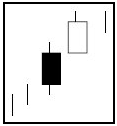
Separating
lines bullish |
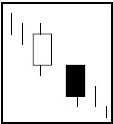
Separating
lines bearish |
Separating Lines
Separating lines are a continuation pattern
in either an uptrend or downtrend. In an
uptrend, a black candlestick is followed by a
white candlestick with the same opening price.
In a downtrend, a white candlestick is followed
by a black candlestick with the same opening
price. In either case, the existing trend
continues.
 |
Bullish on Neck Line and in
Neck Line
Bullish on neck line and in
neck line candlesticks are small one-day
contratrend reversals that do not amount
to much. In an uptrend, there is a gap
up open followed by some continuation up
to a new high. A mild reversal by the
close produces a black candlestick, but
the downward movement is not enough to
produce a negative net price change
close to close. The uptrend resumes the
next session.
Bearish on Neck Line and in
Neck Line
Similarly, bearish on neck line and in
neck line candlesticks are small one-day
contratrend reversals that do not amount
to much. In a downtrend, there is a gap
down open followed by some continuation
down to a new low. A mild reversal by
the close produces a white candlestick,
but the upward movement is not enough to
produce a positive net price change
close to close. The downtrend resumes
the next session. |
Side-by-Side White Lines
Side-by-side white lines occur after a window
(gap) within an existing trend, up or down. The
second line is an inside day, with a lower high
and higher low. This marks consolidation, and
the existing trend quickly resumes.
Windows
The window, known as a gap in the West,
occurs anytime when the current price range does
not overlap the previous period's price range.
Windows are usually continuation patterns
indicating the existing trend before the window
is likely to continue after the window. For the
trend to continue, the window should function as
a support in an uptrend or as resistance in a
downtrend. The window should not be closed, or
filled in, on a closing price basis. If the
window is closed on a closing price basis, the
trend is over.
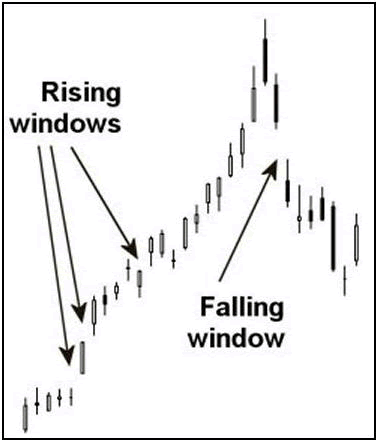
Source:
VantagePoint Intermarket Analysis
Software |
Windows are very powerful and
important indications of demand and
supply. Windows following congestion
patterns validate the new trend
direction, giving the same signal as
Western breakaway gaps.
Rising Window
For a rising window, the current
period's low is higher than the previous
period's high, leaving an upside gap on
the chart. A downward reaction or
correction against the uptrend is likely
to find support within the window – that
is, the previous period's high should
offer support to any downward reaction
against the uptrend.
Falling Window
For a falling window, the current
period's high is lower than the previous
period's low, leaving a downside gap on
the chart. An upward reaction or
correction against the downtrend is
likely to find resistance within the
window – that is, the previous period's
low should offer resistance to any
upward reaction against the downtrend. |
|
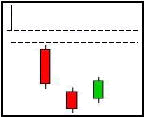
Tasuki gap bottom |
Tasuki Gap
Tasuki gap is the name of a brief,
contratrend retracement that may enter
the area of a recent window but does not
close the window on a closing price
basis. |
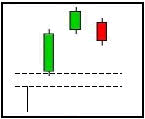
Tasuki gap top |
Meeting Line
Meeting line is defined by a window (gap) in
the direction of the prevailing trend on the
open, but the close reverses to meet the
previous period's close. This should not happen
if the trend is to continue, so the trend is
likely to reverse.
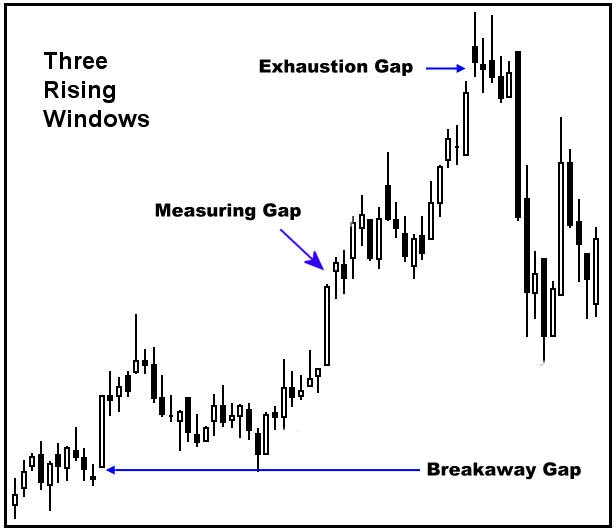
Source:
VantagePoint Intermarket Analysis Software
Three Windows
Three windows often signal the end of a move.
The first gap is the breakaway gap that
initiates a move. The second gap is a
continuation gap or measuring gap that often
occurs halfway into a move. The third gap is an
exhaustion gap that occurs at the end of a move.
Three falling windows are three
downside gaps followed by a bullish white
candlestick to indicate selling pressure is
exhausted. Three rising windows
are three upside gaps followed by a bearish
black candlestick to indicate buying pressure is
exhausted.
Candlestick Reversal Bottoms
In addition to depicting the trading action
during a given time period more visually,
candlestick charts also provide a more visual
picture of price reversal patterns signaling the
market may be ready to start a new trend.
One candlestick itself can provide important
information about the strength or weakness of
the market during a given day or other time
period and can suggest a price turn. However, it
typically takes several candlesticks to produce
chart formations that give the best candlestick
signals. Of course, much depends on where a
given candle or candlestick formation occurs
during the market action, a point that cannot be
emphasized too much, as candlesticks may look
identical but have a different meaning after an
uptrend than they do after a downtrend.
Here are some candle signals at a bottom
suggesting the previous downtrend should reverse
into a bullish uptrend.
 |
Hammer or Shaven Head
The hammer (takuri) is a
bullish reversal pattern occurring
within an established downtrend. It has
a small real body (white or black) at or
near the high (thus, little or no upper
shadow), and it has a long lower shadow,
which implies that extreme low prices
were rejected by the market. The
hammer's small real body implies the
previous downtrend is losing momentum.
The market can be said to be
hammering out a base. Another name
applied to a candlestick (white or
black) with no upper shadow is shaven
head. |
 |
Inverted Hammer or Shaven
Bottom
The inverted hammer is a bullish
reversal pattern that follows a
downtrend. It has a small real body
(white or black), long upper shadow
(longer than the body) and little or no
lower shadow. This pattern is confirmed
the next day by a strong upside gap on
the open followed by further substantial
upside movement to form a large white
real body. Another name applied to a
candlestick (white or black) with no
lower shadow is shaven bottom. |
 |
Bullish Engulfing Pattern
The bullish engulfing pattern is a major
bottom reversal signal pinpointing a
trend change from bearish to bullish. It
is a two-candlestick pattern where a
small black body for the previous period
is followed by and contained within a
large white body for the current period,
which engulfs one or more previous
candlesticks. |
 |
Piercing Pattern
The piercing pattern (or piercing line)
is similar to the engulfing pattern, but
the signal candlestick does not engulf
the previous candlestick. Following a
long black candlestick for the previous
period, the price gaps lower on the open
for the current period, below the
previous low. Later, the price reverses
strongly upward to close above the
midpoint of the previous period's black
real body. The higher the current close
relative to the previous period's black
real body, the more meaningful is the
piercing pattern. The strong price
reversal demonstrates that the extreme
low price on the open was rejected by
the market and implies that the balance
of power has shifted to the bulls. |
Stars
Stars are reversal patterns that can signal
either a top or bottom, depending on the
previous price trend. There are three main
bullish stars that follow and reverse a
downtrend.
 |
The morning star is
a major bottom reversal signal following
a decline. It is comprised of three
candlesticks: (1) a long black candle;
(2) a gap-lower open and a small real
body (black or white) that should be
entirely below and not touching the real
body of the first candlestick, and (3) a
large white real body that closes well
into the long black body of the first
candlestick. The longer this third white
real body, the more meaningful it is.
Also, a volume surge on this white real
body would add power to the reversal
signal. If the middle candle is a doji,
the pattern is called a morning
doji star and is said to be
more meaningful than an ordinary morning
star. |
 |
If the middle doji's shadows are
completely below without touching the
shadows of the first and third
candlesticks, the pattern is called an
abandoned baby bottom
and is considered to be even more
significant. |
 |
Bullish Harami
The bullish harami, like the star, is a
reversal pattern that can occur at
either a top or bottom. The bullish
version follows a downtrend with a long
black real body for the previous period.
The current period produces a short
white real body, where the current close
is relatively near the open, and both
close and open are contained completely
within the previous period's long black
real body. There should be immediate
upside follow-through the next period
for confirmation. |
 |
Bullish Harami Cross
The bullish harami cross is a major
reversal pattern similar to the bullish
harami, but in a downtrend, a long black
real body is followed by a doji (open
and close at the same price giving a
cross-like appearance) that is contained
within the large black body. |
 |
Three White Soldiers
Three white soldiers reverse an existing
downtrend. Look for three relatively
large, consecutive white candles that
close near or at their highs of the
period. |
 |
Belt Hold
The belt hold appears in a downtrend
when prices open much lower on a large
window (gap) but then close
substantially higher, recovering most of
the early loss. |
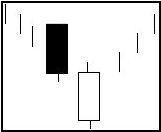 |
Bullish Counterattack Line
In a downtrending market, a large black
candlestick is following by a large
white candlestick that opens on a big
gap lower and then rallies during the
period to close at the same price as the
previous close. The bullish white
candlestick needs followup action to the
upside to confirm the turn to an
uptrend. |
Three Inside Up
Three inside up is composed of three
candlesticks. Following a prevailing downtrend,
the first is a large black candle. This is
followed by a short white candle that is
contained entirely within the real body of the
previous big black candle. This suggests some
loss of downward price momentum. The third
candlestick is a large white candlestick that
closes above the highs of the previous two
candlesticks, thus confirming a bullish change
in trend direction.
Three Outside Up
Three outside up is also composed of three
candlesticks following a prevailing downtrend.
First look for a black candlestick. This is
followed by a larger white candlestick that is
an engulfing line – that is, its real body
contains the entire first period's price range.
This alone suggests a change in downward price
momentum. The third candlestick is a large white
candle that closes above the highs of the
previous two candlesticks, thus confirming a
bullish change in trend direction.
Ladder Bottom
Ladder bottom reverses a bearish downtrend.
After three consecutive and decisive selling
sessions forming three substantial black
candles, there may be some slowing of downward
momentum in the fourth period. The trend change
from bear to bull is confirmed in the fifth
period by a relatively large white candlestick
that closes on its high and at a new high
relative to the most recent past three periods.
Kicking
Kicking is a two-day bear trap. Following a
decisive day of selling where prices open on
their highs and close on their lows, forming a
substantial black candlestick with no shadows,
prices totally reverse on the open the very next
day, forming a rising window on a large upside
opening price gap. Prices close that day on
their highs, forming a substantial white
candlestick with no shadows. The bears can't
help but suffer big losses, and they are likely
to be squeezed further in the days ahead, with
the market showing no mercy. The bears suffer a
severe kicking.
 |
Tweezer Bottoms
Tweezer bottoms are two or more
candlesticks with matching bottoms. The
bottoms do not have to be consecutive,
and size and color are irrelevant. It is
a minor reversal signal that becomes
more important when part of a larger
pattern. |
Three Valleys and Three Rivers
Three valleys bottom and three rivers bottom
are longer-term patterns similar to the western
world's triple bottom. A buy signal is confirmed
when the price rises above the intervening two
rally tops, preferably on a strong, large white
candlestick or a rising window (breakaway gap)
and a rise in trading volume to indicate strong
buying.
Inverted Three Buddha Bottom
Inverted three Buddha bottom is a longer-term
pattern similar to a western inverted
head-and-shoulders bottom. A buy signal is
confirmed when the price rises above the
intervening two rally tops, preferably on a
strong, large white candlestick or a rising
window (breakaway gap) and a rise in trading
volume to indicate strong buying.
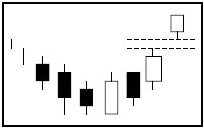 |
Fry Pan Bottom
Fry pan bottom is a western rounding
bottom, where a buy signal is validated
by a rising window (breakaway gap) to
indicate strong buying. |
Candlestick Reversal Tops
Candlesticks with similar appearances can
signal much different outcomes, depending on
whether the individual candle or candlestick
formation occurs after an extended downtrend or
uptrend or in the middle of a trend. Here are
some candlestick signals at tops that suggest
the previous uptrend may be ready to reverse
into a bearish downtrend.

|
Hanging Man
The hanging man is a bearish reversal
pattern occurring within an established
uptrend. It has a small real body (white
or black) at or near the high;
therefore, it has little or no upper
shadow. Although the color of the real
body is not critical, black is more
bearish than white. Also, it has a long
lower shadow, like legs dangling down
from the body. The hanging man's small
real body implies the previous uptrend
is losing momentum. The next period’s
action would confirm the bearish
implications of the hanging man if there
is a downward window (gap) or a long
black candlestick. |

|
Bearish Engulfing Pattern
The bearish engulfing pattern is defined
as a current large real body enveloping
a smaller white real body formed by
price action during the previous period.
Supply overwhelms demand. The bulls are
immobilized. |
 |
Dark Cloud Cover
The dark cloud cover is a decisive black
candlestick following a strong white
candlestick with an opening gap up to a
new high, a reversal and weak close well
into the previous white real body. The
weaker the second black candlestick’s
close, the more meaningful and bearish
it is. For example, a close near the low
of the current black candlestick and
below the midpoint (or lower) of the
previous white real body would be
significant. This candlestick indicates
bulls led a charge up the mountain to
new price highs but could not hold the
ground. Now the bears are pushing them
back down the mountain. Dark cloud cover
is the opposite of the piercing line. |
Stars
Stars are reversal patterns. There are four
main bearish stars that follow and reverse an
uptrend.
 |
The shooting star
has a long upper shadow, a small real
body at the lower end of the price range
and little or no lower shadow. After an
upward move in previous sessions, a
strong rally from the open occurs, but
the market rejects the high prices and
prices collapse back down to close near
the open. This means that after early
buying enthusiasm on the open, the rally
attempt proved unsustainable, an obvious
failure of demand. It is more
significant if the current open gaps up
from the previous real body. |
 |
More significant is the more complex
evening star, which
comprises three candlesticks: First, a
long white candle; second, a gap-higher
open and a small real body (black or
white), which should be completely above
but not touching the real body of the
first candle; and third, a black real
body that closes well into the white
body of the first candlestick. The
longer this third black real body, the
more meaningful it is. A volume surge on
this third black real body would add
power to the reversal signal. |
If the middle candle is a doji, the pattern
is called an evening doji star,
which is more significant than an ordinary
evening star.
 |
If the middle doji’s shadows are
completely above and do not touch the
shadows of the first and third
candlesticks, the pattern is called an
abandoned baby top and
is even more significant. |
Tri-Star is a rare but
significant reversal pattern formed by three
dojis, the middle one a doji star that gaps up
and away from the previous period’s candlestick.
Tri-star often follows a trend of long duration
that has run its course. The three dojis clearly
indicate a loss of momentum and an exhaustion of
the trend.
 |
Bearish Harami
The bearish harami is a reversal pattern
following an uptrend, formed a long
white real body during the previous
period and a short black real body
during the current period where the
current close is relatively near the
open, and both close and open are
contained completely within the previous
period’s long white real body. There
should be immediate downside
follow-through in the next period for
confirmation. |
 |
Bearish harami cross
is a major reversal pattern. In an
uptrend, a long white real body is
followed by a doji, and that doji is
contained within the previous large
white body. |
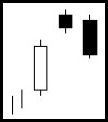 |
Two Crows
Two crows reverse an existing uptrend.
First, there appears a relatively small
black candlestick that signals a loss of
upside momentum. That small black
candlestick is immediately followed by a
much more substantial black candlestick,
which confirms a bearish change in
momentum. |
 |
Three Black Crows
Three black crows more decisively
reverse an existing uptrend. Look for
three relatively large, consecutive
black candlesticks that close near or at
their lows of the period. If the three
candlesticks are identical, the pattern
is called identical three black
crows. |
 |
Belt Hold
Belt hold, in an uptrend, forms when
prices open much higher on a large
window (gap) but close substantially
lower, giving up most of the early gain. |
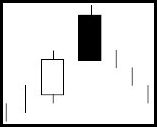 |
Bearish Counterattack Line
In an uptrending market, a large white
candlestick is following by a large
black candlestick that opens on a big
gap higher and then slumps back during
the period to close at the same price as
the previous close. The bearish black
candlestick needs followup action to the
downside to confirm the turn to a
downtrend. |
Three Inside Down
Three inside down is composed of three
candles. Following a prevailing uptrend, first
look for a large white candlestick. This is
followed by a short black candlestick, which is
entirely contained within the real body of the
previous big white candlestick. This suggests
some loss of upward price momentum. The third
candlestick is a large black candlestick that
closes below the lows of the previous two
candlesticks, thus confirming a bearish change
in trend direction.
Three Outside Down
Three outside down is also composed of three
candlesticks. Following a prevailing uptrend,
first look for a white candlestick. This is
followed by a larger black candlestick, which is
an engulfing line – that is, its real body
contains the entire previous period’s price
range. This alone suggests a change in upward
price momentum. The third candlestick is a large
black candlestick that closes below the lows of
the previous two candlesticks, thus confirming a
bearish change in trend direction.
Kicking
Kicking can also be a two-day bull trap.
Following a decisive day of buying where prices
open on their lows and close on their highs,
thus forming a substantial white candle with no
shadows, the very next day prices totally
reverse on the open, forming a falling window on
a large downside opening price gap. Prices close
that day on their lows, forming a substantial
black candle with no shadows. The bulls can’t
help but suffer big losses, and they are likely
to be punished by further price weakness in the
days ahead, with the market showing no mercy.
The bulls suffer a severe kicking.
Deliberation
Deliberation occurs in an uptrend with a
three white candlestick pattern where the first
two are substantial but the third is small. This
indicates a loss of upward momentum, as if the
market is preparing for a trend change from up
to down.
Advance Block
Advance block occurs in an uptrend when there
are three consecutive white candlesticks with
the second and the third both exhibiting a
smaller price range and real body than the
previous one, thus indicating diminishing upward
price momentum.
Ladder Top
Ladder top reverses a bullish uptrend. After
three consecutive and decisive buying sessions
forming three substantial white candlesticks,
there may be a noticeable slowing of upward
momentum in the fourth period. The trend change
from bull to bear is confirmed in the fifth
period by a relatively large black candlestick
that closes on its low and at a new low relative
to the most recent past three periods.
 |
Tweezer Tops
Tweezer tops are two or more
candlesticks with matching tops. The
tops do not have to be consecutive, and
size and color are irrelevant. It is a
minor reversal signal that becomes more
important when part of a larger pattern.
A sell signal is confirmed when the
price falls below the intervening two
minor pullback lows, preferably on a
large black candlestick or a falling
window (breakaway gap) and a rise in
trading volume to indicate serious
selling. |
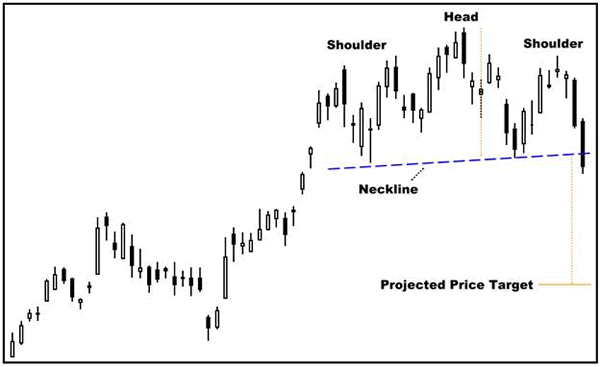
Source:
VantagePoint Intermarket Analysis Software
Three Buddha Top
Three Buddha top is a longer-term pattern
similar to a Western head-and-shoulders top. A
sell signal is confirmed when the price falls
below the intervening two minor pullback lows,
preferably on a large black candlestick or a
falling window (breakaway gap) and a rise in
trading volume to indicate serious selling.
Three Mountains Top
Three mountains top is a longer-term pattern
similar to a Western triple top. A sell signal
is confirmed when the price falls below the
intervening two minor pullback lows, preferably
on a large black candlestick or a falling window
(breakaway gap) and a rise in trading volume to
indicate serious selling.
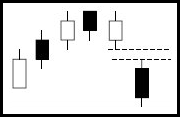 |
Dumping Top
Dumping top is a longer-term pattern
similar to a Western rounding top, where
a sell signal is validated by a falling
window (breakaway gap) to indicate
overwhelming supply. |
Eight New Price Lines
Eight new price lines is a chart pattern
consisting of eight new price highs. This
implies an overbought market where profit-taking
would be appropriate.
Quick Guide to Main Patterns
Candlestick charts give a more visual
presentation of price action than traditional
bar charts and have become the chart of choice
for many technical analysts.
One candle itself can provide important
information about the strength or weakness of
the market during a given day or other time
period, depending where the close is relative to
the open. However, a candlestick pattern usually
takes several candles to produce chart
formations that give the best signals.
The key in candlestick chart analysis is
where a given candle or candle formation occurs
during the market action. Candlesticks may look
identical but have an entirely different meaning
after an uptrend than they do after a downtrend.
The diagrams and descriptions below cover
only some of the main candlestick patterns,
showing the bullish version on the left and
bearish version on the right. There are many
other candlestick patterns with clever names
that chart analysts use.
| Bullish |
Description |
Bearish |
 |
"Doji stars" -
Prices at the open and close of the
period are at the same level, indicating
indecisiveness about price direction.
The signal tends to be more dependable
when it appears at a top than at a
bottom. |
 |
 |
"Stars" - Stars are
reversal patterns and come in several
different forms. The pattern consists of
three candles, the first usually a large
candle at the end of an extended trend
followed by a smaller candle that leaves
a gap or window and then another large
body candle in the direction of the new
trend. Large volume would help to
confirm the reversal signal. |
 |
 |
"Piercing line" and
"dark cloud cover" -
These reversal patterns are mirror
images of one another and are close
relatives of the engulfing patterns
except that the current candle’s body
does not engulf the previous candle.
Instead, the market has a gap opening,
then moves sharply in the opposite
direction and closes more than halfway
through the previous candle’s body. |
 |
 |
"Hammer" and
"Hanging Man" - These
two reversal patterns look very much
alike, but their name and impact on
prices depend on whether they occur at
the end of a downtrend or an uptrend.
The signal candlestick has a small real
body and a long lower shadow, suggesting
the previous trend is losing momentum.
This pattern also requires confirmation
by the next candle. |
 |
 |
"Harami" - The
harami is a reversal pattern following a
trend. Rather than engulfing the
previous candle, price action for the
current candle is entirely within the
range of the previous candle body. This
pattern requires immediate
follow-through for confirmation. |
 |
 |
"Engulfing patterns" -
Prices open below the previous
close (bullish) or above the previous
close (bearish) and then stage a strong
turnaround, producing a candle body that
totally engulfs the previous candle and
suggesting a change in trend direction. |
 |
 |
"Tweezers" -
Tweezers are minor reversal signals that
are more important if they are part of a
larger pattern. A tweezer bottom has two
or more candles with matching bottoms; a
tweezer top has two or more candles with
matching tops. They do not have to be
consecutive candles. They do require
follow-through for confirmation. |
 |
TradingEducation.com |